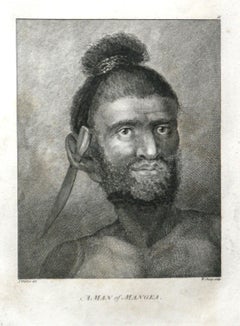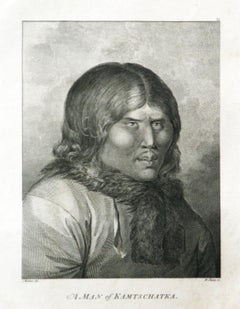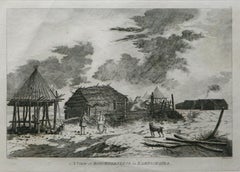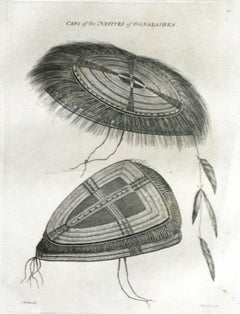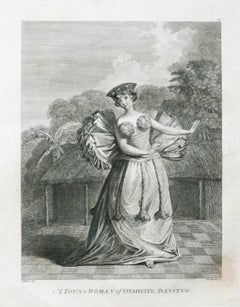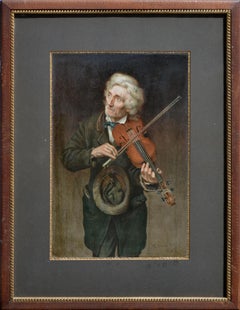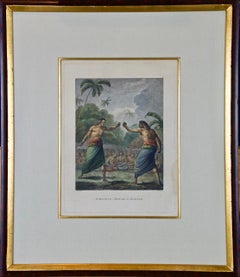John Webber Art
to
16
4
10
6
2
12
2
Overall Height
to
Overall Width
to
14
5
5
5
4
3
3
3
2
2
2
2
1
1
1
1
15
1
15
18
6,997
3,373
2,513
1,212
16
Artist: John Webber
A Man of Mangea 1784 final voyage of Captain Cook by John Webber
By John Webber
Located in Paonia, CO
A Man of Mangea is from the 1784 First Edition Atlas Accompanying Capt. James Cook and King; Third and Final Voyage of Captain James Cook. John Webber (1752-1793) was the official a...
Category
1780s Realist John Webber Art
Materials
Engraving
A Man of Kamtschatka (Russia) 1784 Captain Cooks Final voyage by John Webber
By John Webber
Located in Paonia, CO
A Man of Kamtschatka (Russia) is from the 1784 First Edition Atlas Accompanying Capt. James Cook and King; Third and Final Voyage of Captain James Cook. John Webber (1752-1793) was t...
Category
1780s Realist John Webber Art
Materials
Engraving
A View at Bolcheretzko (Russia) 1784 Captains Cook Final Voyage by John Webber
By John Webber
Located in Paonia, CO
A View at Bolcheretzko (Russia) is from the 1784 First Edition Atlas Accompanying Capt. James Cook and King; Third and Final Voyage of Captain James Cook.John Webber (1752-1793) was ...
Category
1780s Realist John Webber Art
Materials
Engraving
Caps of the Natives of Oonalashka (Alaska) Captain Cooks Voyage by John Webber
By John Webber
Located in Paonia, CO
Caps of the Natives of Oonalashka (Alaska) is from the 1784 First Edition Atlas Accompanying Capt. James Cook and King; Third and Final Voyage of Captain James Cook. John Webber (175...
Category
1780s Realist John Webber Art
Materials
Engraving
A Young Woman of Otaheite, Dancing (Tahiti) 1784 Captain Cooks Voyage by Webber
By John Webber
Located in Paonia, CO
A Young Woman of Taheite Dancing (Tahiti) is from the 1784 First Edition Atlas Accompanying Capt. James Cook and King; Third and Final Voyage of Captain James Cook.John Webber (1752-...
Category
1780s Realist John Webber Art
Materials
Engraving
"King of the Friendly Islands" (Tonga); Engraving from Captain Cook's 3rd Voyage
By John Webber
Located in Alamo, CA
"Poulaho, King of the Friendly Islands, Drinking Kava" is an engraving created by William Sharp (1749-1824), from a drawing by John Webber (1752-1793), who was the artist on Captain James Cook's 3rd and final voyage of discovery. It was published in the atlas of "A Voyage to the Pacific Ocean Undertaken by the Command of His Majesty, for Making Discoveries in the Northern Hemisphere", the official British Admirality sanctioned journal published upon completion of the voyage in London in 1784 by Strahan & Cadell.
Captain Cook visited Tonga on his 3rd voyage, which he named The Friendly Islands because of the warm welcome he and his crew received, unlike some of the other more hostile Pacific islands. The engraving depicts Cook and his men observed a kava ceremony at the village of Mu’a on Tongatapu. King Paulaho sits in the centre foreground, his back to the spectator with a man kneeling before him. The ceremonial mat depicted behind Paulaho indicates that nobody was allowed to sit behind him. The figure in the centre holds a single cup, referring to the Tongan custom of offering the cup to the king first. Kava is native to the islands of the South Pacific and was first described for English readers in 1768 by Captain James Cook. The kava root has been used for centuries as a central feature of ceremonies and celebrations because it was able to bring about a calming and pleasant social atmosphere. The root was crushed and processed into coconut milk to become the focal ceremonial beverage, simply referred to as kava.
This engraving is presented in a Koa wood frame and a white mat. Koa wood is legendary in Hawaii. There are occasional faint spots, but the print is otherwise in very good condition. This amazing Koa wood is native to Hawaii and it is known for the deep rich colors and varied grain pattern. Koa has an honored heritage in Hawaii and is highly revered and sacred. The word “koa” means “warrior” in Hawaiian. The warriors of King Kamehameha the Great, created canoes and weapons from a wood plentiful on the Big Island of Hawaii. This wood became synonymous with the warriors themselves, and it became known as koa.
There are three other engravings listed from the official journal of Captain Cook's 3rd voyage available that are presented in identical Koa wood frames and mats (LU117324682422, LU117324684052, LU117324684032). They would make a wonderful grouping for a display of 2, 3 or 4 prints. A discount is available for a grouping depending on the number of items included.
Captain Cook is remembered as one of the greatest explorers and navigators in history. His explorations included Australia, New Zealand and islands of the South Pacific and the northwest coast of North America. Hawaii was discovered by Captain Cook during this voyage. Hawaii was originally called The Sandwich Islands in honor of The Earl of Sandwich...
Category
1780s Realist John Webber Art
Materials
Engraving
A Man of the Sandwich Islands, Dancing (Hawaii) from Captain Cooks travels engra
By John Webber
Located in Paonia, CO
A Man of the Sandwich Islands Dancing (Hawaii) is from the 1784 First Edition Atlas Accompanying Capt. James Cook and King; Third and Final Voyage of Captain James Cook. John Webber (1752-1793) was the official artist for the third voyage of Captain James Cook (1728-1779). The purpose of this voyage was to discover the Northwest Passage and to explore the Pacific Ocean north of the Equator. These engravings were published in 1784-85 by G. Nichol and Thomas Cadell of London in the four large format atlas, Voyage to the Pacific Ocean. Captain Cook was an extraordinary explorer known for discovering and mapping unknown territory and for his many contributions to the scientific world. These original engravings from Webber’s drawings and paintings are only a glimpse into this great man’s historical contributions that make him one of the greatest explorers of all times.
This image shows a Hawaiian dancer...
Category
1780s Realist John Webber Art
Materials
Engraving
The Inside of a Hippah in New Zealand from Captain Cooks Travels
By John Webber
Located in Paonia, CO
The Inside of a Hippah in New Zealand is from the 1784 First Edition Atlas Accompanying Capt. James Cook and King; Third and Final Voyage of Captain James Cook John...
Category
1780s Realist John Webber Art
Materials
Engraving
A Human Sacrifice, in a Morai, in Otaheite (Tahiti) 1784 James Cook Final Voyage
By John Webber
Located in Paonia, CO
A Human Sacrifice in a Morai in Otaheite (Tahiti) 1784 by John Webber is from the First Edition Atlas Accompanying Capt. James Cook and King; Third and Final Voyage of Captain...
Category
1780s Realist John Webber Art
Materials
Engraving
A Dance in Otaheite (Tahiti) 1784 James Cook Final Voyage by John Webber
By John Webber
Located in Paonia, CO
A Dance in Otaheite ( Tahiti ) is from the 1784 First Edition Atlas Accompanying Capt. James Cook and King; Third and Final Voyage of Captain James Cook. John Webber (1752-1793) who...
Category
1780s Realist John Webber Art
Materials
Engraving
An Inland View; in Atooi ( Hawaii ) 1784 Captain Cook engraving by John Webber
By John Webber
Located in Paonia, CO
An Inland View in Atooi ( Hawaii ) is from the 1784 First Edition Atlas Accompanying Capt. James Cook and King; Third and Final Voyage of Captain James Cook. This engraving depicts ...
Category
1780s Realist John Webber Art
Materials
Engraving
The Body of Tee, a Chief, as preferred after Death, in Otaheite (Tahiti)
By John Webber
Located in Paonia, CO
The Body of Tee a chief as preferred after Death in Otaheite (Tahiti) is from the 1784 First Edition Atlas Accompanying Capt. James Cook and King; Third and Final Voyage of Capt...
Category
1870s Realist John Webber Art
Materials
Engraving
A Group of Four 18th Century Engravings from Captain Cook's 3rd Voyage Journal
By John Webber
Located in Alamo, CA
A grouping of four framed engravings from the atlas of the official British Admirality sanctioned journal of Captain Cook's 3rd Voyage entitled "A Voyage to the Pacific Ocean Undertaken by the Command of His Majesty, for Making Discoveries in the Northern Hemisphere", published upon completion of the voyage in London in 1784 by Strahan & Cadell. These engravings were made from drawings by John Webber (1752-1793), who was the artist on Captain James Cook's 3rd and final voyage of discovery. The set of engravings includes: "A Canoe of the Sandwich Islands, the Rowers Masked", Plate 65 in the atlas; "A Dance in Otaheite" (Tahiti), Plate 28; "King of the Friendly Islands" (Tonga), plate 20; "Inside of a House in Nootka Sound" (Canada), plate 42.
These engravings are professionally framed in Koa wood, the same wood as was used to make the canoes of the ancient Hawaiians. Koa wood is legendary in Hawaii. Not only is this amazing wood native to Hawaii, but it is known for the deep rich colors and varied grain pattern. Koa has an honored heritage in Hawaii and is highly revered and sacred. The word “koa” means “warrior” in Hawaiian. The warriors of King Kamehameha the Great, created canoes and weapons from a wood plentiful on the Big Island of Hawaii. This wood became synonymous with the warriors themselves, and it became known as koa.
These four engravings would make a wonderful grouping for a display of 2, 3 or 4 prints. They may be purchased separately or in groups on 1stDibs. Their listing Reference #'s are: LU117324682432, LU117324682022, LU117324684052 and LU117324684062. A discount is available for a grouping depending on the number of items included.
Hawaii was discovered by Captain Cook (1728-1779) during this voyage. Hawaii was originally called The Sandwich Islands in honor of The Earl of Sandwich...
Category
1780s Other Art Style John Webber Art
Materials
Engraving
"Canoe of the Sandwich Islands" (Hawaii), Engraving of Captain Cook's 3rd Voyage
By John Webber
Located in Alamo, CA
"A Canoe of the Sandwich Islands, the Rowers Masked" is an engraving created by Charles Grignion, from a drawing by John Webber (1752-1793), who was the artist on Captain James Cook's 3rd and final voyage of discovery. It is Plate 65 in the atlas of "A Voyage to the Pacific Ocean Undertaken by the Command of His Majesty, for Making Discoveries in the Northern Hemisphere", the official British Admirality sanctioned journal published upon completion of the voyage in London in 1784 by Strahan & Cadell.
This famous image of ten Hawaiian rowers transporting a priest who is carrying a feather-covered image of Kukailimoku, the Hawaiian god of war. The priests and paddlers are all wearing gourd masks in their double-hulled canoe with an upright lateen woven sail. Each hull was shaped from a single large Koa log harvested from island rainforests, where they were carved before being transported to the coast.
This engraving is presented in a Koa wood frame and a white mat. There are occasional faint spots, but the print is otherwise in very good condition. Koa is the same wood as was used to make the canoe. Koa wood is legendary in Hawaii. Not only is this amazing wood native to Hawaii, but it is known for the deep rich colors and varied grain pattern. Koa has an honored heritage in Hawaii and is highly revered and sacred. The word “koa” means “warrior” in Hawaiian. The warriors of King Kamehameha the Great, created canoes and weapons from a wood plentiful on the Big Island of Hawaii. This wood became synonymous with the warriors themselves, and it became known as koa. The frame measures 20.75" high, 26.75" wide and 0.88" deep.
There are three other engravings listed from the official journal of Captain Cook's 3rd voyage available that are presented in identical Koa wood frames and mat (LU117324682022, LU117324684052, LU117324684062). They would make a wonderful grouping for a display of 2, 3 or 4 prints. A discount is available for a grouping depending on the number of items included.
Hawaii was discovered by Captain Cook (1728-1779) during this voyage. Hawaii was originally called The Sandwich Islands in honor of The Earl of Sandwich...
Category
1780s John Webber Art
Materials
Engraving
"Inside of a House in Nootka Sound" (Canada) from Captain Cook's 3rd Voyage
By John Webber
Located in Alamo, CA
"The Inside of a House in Nootka Sound" is an engraving created by William Sharp (1749-1824), from a drawing by John Webber (1752-1793), who was the artist on Captain James Cook's 3rd and final voyage of discovery. It is Plate 65 in "A Voyage to the Pacific Ocean Undertaken by the Command of His Majesty, for Making Discoveries in the Northern Hemisphere", the official British Admirality sanctioned journal published upon completion of the voyage in London in 1784 by Strahan & Cadell.
This engraving is presented in a Koa wood frame and a white mat. There are occasional tiny faint spots, but the print is otherwise in very good condition. Koa wood is legendary in Hawaii. Not only is this amazing wood native to Hawaii, but it is known for the deep rich colors and varied grain pattern. Koa has an honored heritage in Hawaii and is highly revered and sacred. The word “koa” means “warrior” in Hawaiian. The warriors of King Kamehameha the Great, created canoes and weapons from a wood plentiful on the Big Island of Hawaii. This wood became synonymous with the warriors themselves, and it became known as koa.
There are three other engravings listed form the official journal of Captain Cook's 3rd voyage available that are presented in identical Koa wood frames and mats. They would make a wonderful grouping for a display of 2, 3 or 4 prints. Please see listings: LU117324682432, LU117324684022, LU117324684062. A discount is available for a grouping depending on the number of items included.
Nootka Sound is on the west coast of Vancouver Island, British Columbia, Canada. It was explored by Captain Cook in 1778 after he discovered Hawaii during his 3rd voyage. He originally named it King George's Sound, but did record Nootka Sound, which he thought was its native name. Hawaii was originally called The Sandwich Islands in honor of The Earl of...
Category
1780s Realist John Webber Art
Materials
Engraving
"A Dance in Otaheite" (Tahiti), Engraving from Captain Cook's 3rd Voyage
By John Webber
Located in Alamo, CA
"A Dance in Otaheite" (Tahiti) is an engraving created by William Sharp (1749-1824), from a drawing by John Webber (1752-1793), who was the artist on Captain James Cook's 3rd and final voyage of discovery. It is a plate in the atlas of "A Voyage to the Pacific Ocean Undertaken by the Command of His Majesty, for Making Discoveries in the Northern Hemisphere", the official British Admirality sanctioned journal published upon completion of the voyage in London in 1784 by Strahan & Cadell.
Two women and two men wearing ceremonial costumes, performing a dance outdoors standing on a mat. Three men are playing the drums in the background, in front of a thatched roof building. An audience of men are sitting on both sides of the stage. By the time Webber arrived in Tahiti, 'south sea' imagery had become familiar. Webber gave concentrated attention to dance. He had the opportunity to distinguish the Tahitian dance from the more formalized dancing of Tonga. Whereas they seem to have called to mind the more formal dances of antiquity, the Tahitian dancing aroused memories of peasant and folk dancing.
This engraving is professionally framed in Koa wood. Koa wood is legendary in Hawaii. Not only is this amazing wood native to Hawaii, but it is known for the deep rich colors and varied grain pattern. Koa has an honored heritage in Hawaii and is highly revered and sacred. The word “koa” means “warrior” in Hawaiian. The warriors of King Kamehameha the Great, created canoes and weapons from a wood plentiful on the Big Island of Hawaii. This wood became synonymous with the warriors themselves, and it became known as koa.
The print is in excellent condition.
There are three other engravings listed from the official journal of Captain Cook's 3rd voyage available that are presented in identical Koa wood frames and double mats (LU117324682432, LU117324684052, LU117324684062). They would make a wonderful grouping for a display of 2, 3 or 4 prints. A discount is available for a grouping depending on the number of items included.
Hawaii was discovered by Captain Cook during this voyage. Hawaii was originally called The Sandwich Islands in honor of The Earl of Sandwich...
Category
1780s Realist John Webber Art
Materials
Engraving
Related Items
SEATED SEAMSTRESS Signed Lithograph Young Woman, Dress Form, Rust, Lime Yellow
By Raphael Soyer
Located in Union City, NJ
SEATED SEAMSTRESS is an original hand drawn (not digitally or photo reproduced) limited edition lithograph by the artist Raphael Soyer - Russian/American Social Realism...
Category
1970s Realist John Webber Art
Materials
Lithograph
Old Violinist - Late 19th Century Figurative Lithograph
By John George Brown
Located in Soquel, CA
Finely detailed late 19th century chromo-lithograph portrait of a violinist street musician by John George Brown (British, 1831-1913). Many of Brown’s paintings were reproduced in lithography (Chromo-lithograpy), as is the case with the one offered here. Presented in a rustic antique Oak wood frame with giltwood fillet. Image, 15.63"H x 10.63"W.
John George Brown was a British citizen and an American painter born in Durham, England. His parents apprenticed him to the career of glass worker at the age of fourteen, in an attempt to dissuade him from pursuing painting. He studied nights at the School of Design in Newcastle-on-Tyne while working as a glass cutter there between 1849 and 1852, and evenings at the Trustees Academy in Edinburgh while working at the Holyrood Glass Works between 1852 ad 1853. After moving to New York City in 1853, he studied with Thomas Seir Cummings at the National Academy of Design where he was elected a National Academician in 1861. Brown was the Academy’s vice-president from 1899 to 1904.
Around 1855, he worked for the owner of the Brooklyn Glass Company, and later he married the daughter of his employer. His father-in-law encouraged his artistic abilities, supporting him financially, letting Brown pursue painting full-time. In 1866, he became one of the charter members of the Water-Color Society, of which he was president from 1887 to 1904. Brown became famous for his depictions of street urchins found of the streets of New York (bootblacks, street musicians, posy sellers, newsboys, etc.).
Brown’s art is best characterized as British genre painting...
Category
1870s Realist John Webber Art
Materials
Paper, Lithograph
H 23.5 in W 19 in D 0.75 in
Barack Obama White House portrait print
By Kehinde Wiley
Located in New York, NY
Kehinde Wiley
Portrait of Barack Obama
Color offset lithograph
Based upon the original painting the artist did of President Obama, the official presidential portrait in the permanent...
Category
2010s Realist John Webber Art
Materials
Lithograph, Offset
Vintage 1980 Judaica Chassidic Poster Simchas Torah Hakafos Chabad Artist
By Zalman Kleinman
Located in Surfside, FL
Vintage framed plate signed poster.
Zalman Kleiman, Born in Leningrad, Russia in 1933 into a Lubavitcher Hasidic family, was a self taught Chassidic artist living in Crown Heights, ...
Category
1970s Realist John Webber Art
Materials
Offset
"Conception" - Portrait of a Native American on a Vision Quest
Located in Soquel, CA
"Conception" - Portrait of a Native American on a Vision Quest
Large scale and fine detailed work by the artist. Detailed and evocative depiction of a Native American elder by Frank Howell...
Category
1990s Realist John Webber Art
Materials
Laid Paper, Screen
H 56.75 in W 42.75 in D 1.5 in
Jeune Femme Cousant; Madame Helleu (Young Woman Sewing, artist's wife)
By Paul César Helleu
Located in Middletown, NY
Paris: Gazette des Beaux Arts, 1892.
Etching and dry point on cream laid paper. 7 9/16 x 5 7/8 inches (191 x 148 mm), full margins. Signed in pencil, lower right margin. A dark, ink...
Category
Late 19th Century Realist John Webber Art
Materials
Drypoint, Etching
Sam Colburn Carmel Artist Portrait, Signed Limited Edition Realist Lithograph
By Jack Coughlin 1
Located in Soquel, CA
Highly detailed and realistic portrait lithograph of the modernist watercolor artist Sam Colburn (American, 1909-1993) by Jack Coughlin (American, b. 193...
Category
1980s Realist John Webber Art
Materials
Ink, Paper, Lithograph
Dendera, Egypt, Dec 7th, 1838: David Roberts' 19th C. Duotone Lithograph
By David Roberts
Located in Alamo, CA
This is an original 19th century hand-colored lithograph entitled "Dendera, Dec 7th, 1838" by David Roberts, from his Egypt and Nubia volumes of the large folio edition, published in...
Category
1840s Realist John Webber Art
Materials
Lithograph
Frankfort, Germany: A 16th Century Hand-colored Map by Braun & Hogenberg
By Franz Hogenberg
Located in Alamo, CA
This is a 16th century original hand-colored copperplate engraved map of Frankfort, Germany entitled "Francenbergum, vel ut alij Francoburgum Hassiae Opp" by Georg Braun & Franz Hogenberg, from their famous city atlas "Civitates Orbis Terrarum", published in Cologne, Germany in 1595.
This is an English translation of an excerpt from the original text in the atlas:
"Frankenberg or, according to others, Francoburgum, a town in Hesse. Charlemagne vested the town of Frankenberg with many freedoms and privileges, which it still enjoys to this day, and on account of its valiant and victorious soldiers awarded a signet, upon which there formerly appeared a golden castle with a tower, together with the letter F and a golden crown.
Frankenberg, seen here from the northeast, lies on a hill above the River Eder. The hillside is covered with fields neatly separated by bushes and fences. Soaring above the town is the massive Liebfrauenkirche, which was modelled on St Elizabeth's church in Marburg. The New Town was founded in 1335 at the foot of the hill (right) and merged with the Old Town as late as 1556. Frankenberg was founded by Conrad of Thuringia in 1233/34 to prevent the archbishops of Mainz from expanding their sphere of influence...
Category
16th Century Old Masters John Webber Art
Materials
Engraving
Judaica Woodcut Print Jewish Rabbi Hachnasas Torah Procession Woodblock
Located in Surfside, FL
This does not appear to be signed. not examined out of frame. In the manner of Frans Masereel here is an old woodblock print of a Jewish religious scene of the induction of a new torah in a procession with a chuppah, wedding canopy. In the tradition of the Jewish European artists of the 19th and early 20th centuries, such as Moritz Oppenheim, Max Liebermann, Lesser Ury, Jakob Steinhardt, Jehudo Epstein, Artur Kolnik, Stanislaus Bender...
Category
Early 20th Century Realist John Webber Art
Materials
Woodcut
Vintage Le Corbusier '69 David Hockney Exhibition Poster Kilim southwest rug
By (after) David Hockney
Located in New York, NY
Shading in bright turquoise above a Southwestern style thunderbird Kilim rug adorns this original exhibition poster for David Hockney's 1969 show at Andre Emmerich, New York. This po...
Category
1960s Realist John Webber Art
Materials
Lithograph
Vintage Hockney Tate Poster, Celia in Black Dress with white flowers and rainbow
By David Hockney
Located in New York, NY
The poster reproduces David Hockney's 1972 drawing Celia in a Black Dress. Viewed through elegantly drooping tulip stems, Celia Birtwell stares dreamily ahead. With one hand paused i...
Category
1980s Realist John Webber Art
Materials
Lithograph
Previously Available Items
A Young Woman of the Sandwich Islands Captain Cooks travels engraving J. Webber
By John Webber
Located in Paonia, CO
A Young Woman of the Sandwich Islands is from the 1784 First Edition Atlas Accompanying Capt. James Cook and King; Third and Final Voyage of Captain James Cook. John Webber (1752...
Category
1780s Realist John Webber Art
Materials
Engraving
"A Boxing Match Hapaee" (Tonga) Engraving of Captain Cook's 3rd Voyage by Webber
By John Webber
Located in Alamo, CA
"A Boxing Match Hapaee" (Tonga) is an engraving created by I. Taylor, from a drawing by John Webber (1752-1793), who was the artist on Captain James Cook's 3rd and final voyage of discovery. It is Plate 15 in the atlas of "A Voyage to the Pacific Ocean Undertaken by the Command of His Majesty, for Making Discoveries in the Northern Hemisphere", the official British Admirality sanctioned journal published upon completion of the voyage in London in 1784 by Strahan & Cadell.
This famous image of a boxing match in honor of Captain Cook and his crew on their arrival on the island of Hapeea, which is in modern day Tonga. Cook referred to the chain of islands as "The Friendly Islands" due to his warm welcome by its inhabitants. These long-haired boxers are shirtless, shoeless, attired in skirts that extend to and below their knees and their hands are wrapped in string. A large group of Tongans spectators are seen in the backgropund.
This engraving is beautifully and skillfully hand colored and professionally framed in a reddish brown wood frame with black and light brown flecks and a gold-colored inner trim. There is a cream-colored fabric mat and a distinctive gold-colored wood fillet. There is a faint crease or closed tear in the left upper margin which may extend slightly into the print, an area of discoloration in the lower right margin and a small spot in the right lower margin, but the print is otherwise in very good condition. There are minor frame abrasions.
Captain Cook is the greatest explorer of the 18th century "Age of Discovery" and one of the greatest explorers of all-time. He discovered many Polynesian islands, explored and surveyed their coastlines, as well as those of Australia, New Zealand, the Northwest coast of North America and adjacent portions of Russia. After discovering Hawaii, which he named The Sandwich Islands, he was killed by natives in Kealakekua Bay on the big island of Hawaii in 1779. His ships the Resolution and Discovery then returned to England. Other notables who were part of this expedition included Captain William Bligh, Cook's sailing master, who would later go down in history as captain of the mutinous crew of the Bounty and George Vancouver...
Category
1780s Naturalistic John Webber Art
Materials
Engraving
H 22.13 in W 17.63 in D 0.75 in
Representation of Human sacrifice with Captain Cook
By John Webber
Located in Saint Augustine, FL
An original copperplate engraving on wove paper after English artist John Webber (1751-1793) titled "Representation of a Human Sacrifice in a Morai at Otaheite in the presence of Captain Cook...
Category
1810s Victorian John Webber Art
Materials
Copper
John Webber art for sale on 1stDibs.
Find a wide variety of authentic John Webber art available for sale on 1stDibs. You can also browse by medium to find art by John Webber in engraving and more. Not every interior allows for large John Webber art, so small editions measuring 24 inches across are available. Customers who are interested in this artist might also find the work of James Carter, Frank Henry Mason, and Antoine Calbet. John Webber art prices can differ depending upon medium, time period and other attributes. On 1stDibs, the price for these items starts at $1,900 and tops out at $7,660, while the average work can sell for $1,900.
